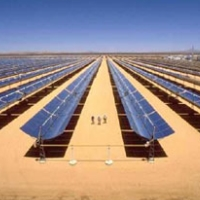Big Boost in California Solar Power Barely Offsets Loss of Hydroelectric
 (graphic: California Energy Commission)
(graphic: California Energy Commission)
The same abundant sunshine (read that as cloudless skies) that allowed California to derive 5% of its energy from solar power in 2014—more than the rest of the nation combined—has contributed mightily to drought and the loss of hydroelectric power.
The U.S. Energy Information Administration (EIA) reported this week that California nearly tripled its 2013 solar output, while noting at the same time that hydroelectric power use in the state was down 46% last year compared to the five-year average.
Overall, the state’s use of renewable energy sources inched up a bit last year, thanks to an increase in wind power and a steady contribution from biomass and geothermal. But the total is far below the 2011 figure, before the four-year drought kicked in and hydroelectric power was more than double the current output.
The state’s current clean air mandate is for 33% of the state’s energy to come from renewable sources by 2020 and 50% by 2030.
Critics have questioned whether those numbers are feasible in light of growing conflicts between developers of large solar projects and environmentalists who warn of devastating consequences for delicate desert ecosystems and wildlife, endangered or otherwise, that venture too close to the facilities.
Most of the increase in solar output in California was a result of four large plants coming online during 2014. Nearly 1,900 megawatts of power was generated by the new plants, bringing the state’s total capacity to 5,400 MW.
But a study released this month in the journal Nature Climate Change found that large plants are not necessary. Researchers at Stanford University's Carnegie Institution for Science said the 12,000 square miles of California that human beings have already mucked around with (cities, parks, landfills, industrial zones, etc.) provide sufficient space to put up photovoltaic panels like the ones on people’s homes and potentially produce five times the energy used by the state.
The study also said an alternative approach, putting parabolic trough power plants in out-of-the-way industrial zones, alone could generate 2.7 times what the state needs.
California still has a way to go before approaching the accomplishments of Costa Rica. The Central American nation of about 4.6 million people reported this week that the country had gone 75 straight days using only electricity from renewable energy. But Costa Rica is the mirror image of California, where 68% of its renewable energy is produced by hydroelectric sources, thanks to bountiful rains.
That makes it as vulnerable to shifting climate changes as California. Even the slightest change in rain patterns can ruin Costa Rica’s energy plans and thrust it back into the world of fossil fuels. And if there is one thing the planet can count on from Mother Nature in the future, it is climate change.
–Ken Broder
To Learn More:
California First State to Generate More Than 5% of Electricity from Utility-Scale Solar (U.S. Energy Information Administration)
California Leads Nation in Solar Power (by Nick Cahill, Courthouse News Service)
No Need to Sacrifice California Wildlands for Solar, Study Finds by Chris Clarke, KCET)
Costa Rica Has Gotten All of Its Electricity From Renewables for 75 Days Straight (by Katie Valentine, ThinkProgress)
Efficient Use of Land to Meet Sustainable Energy Needs (by Rebecca R. Hernandez,
Madison K. Hoffacker, and Christopher B. Field, Nature Climate Change)
- Top Stories
- Controversies
- Where is the Money Going?
- California and the Nation
- Appointments and Resignations
- Unusual News
- Latest News
- California Forbids U.S. Immigration Agents from Pretending to be Police
- California Lawmakers Urged to Strip “Self-Dealing” Tax Board of Its Duties
- Big Oil’s Grip on California
- Santa Cruz Police See Homeland Security Betrayal in Use of Gang Roundup as Cover for Immigration Raid
- Oil Companies Face Deadline to Stop Polluting California Groundwater





